The Loach Almanac
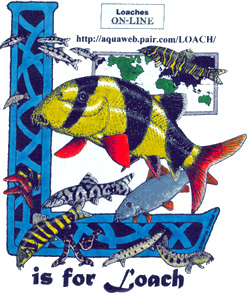
A big thank-you from Loaches Online goes out to the following people who helped make the Almanac possible:
Writers
- Steve Burton - Project Coordinator
- Everyone on the Loach Forum who contributed their thoughts and suggestions!
Visual Artists
- Martin Thoene - Artist of images such as the "L is for Loach" design
- Nancy and Paul Boden - "Modesta in the Cave" photo
- James Forgan (James Western Canada) - "Gravel Flowerpot Cave"
Tank Environment
Water Chemistry
The water chemistry for most loaches is fairly broad, and are not too fussy about what they are kept in, provided they have been slowly acclimated to it over a period of time. Extremes of pH, general hardness, carbonate hardness, etc, should be avoided. Ammonia, nitrites and nitrates are all toxic to fish in varying concentrations. Ammonia and nitrite should particularly be avoided at all costs – any measurable amount of these, and the underlying causes should be immediately investigated – an immediate 40-50% water change should also be undertaken (where practical). Ammonia and nitrite levels will be expected to rise and fall during the cycling (maturation) of a freshly setup aquarium – changing water at this point will only prolong the cycling period as the bacteria used to break down these toxic product will take longer to establish. Nitrate levels are not so crucial, but should generally be kept below 50PPM. Dissolved Organic Compounds may also cause long-term health problems, and so should be kept within reasonable levels. As far as I’m aware, there are no test kits available to measure DOC levels at this moment in time, but it can be assumed that DOC levels will be reduced along with nitrate levels as the result of a water change.
Water Changes
Should be routinely performed. People tend to have their own criteria for deciding when a water change becomes necessary. Books also have their own opinions about water changes and schedules. I personally aim to replace approximately 25% at least fortnightly. The amount changed will depend a lot on stocking levels, how messy the fish are, the original quality of the change water, etc. I don’t really intend on going into how much, how often, what water treatments should be used, etc, as I’ll be here for a month of Sundays, and I’ll only be repeating what most books, magazine articles and experts have already stated. What works for me is a 25% change every fortnight, with tapwater that has been heavily aerated for at least 2 days, and brought up to tank temperature prior to the change. What I don’t really find necessary is reverse osmosis, adding trace elements, filtering over peat, water softening pillows, dechlorinators, products containing aloe vera, etc. Similarly, I don’t rely on test kits to tell me when something is wrong with the water – the fish will tell me by behaving odd, respiratory rates, etc, as will the smell, color and "feel" of the water. What I will say about preparing water for water changes, is to find out what condition the water is in before beginning any preparation regime. Water varies tremendously, whether it be tapwater, citywater, well-water, etc.
Substrate
Loaches, being in the main part, bottomdwellers will appreciate
a soft, sandy (or small pebbles) substrate that they can dig around in to their
hearts content. Silver sand (playpit sand), freshwater aquatic sand, pea gravel
(up to 3mm) would be ideal – avoid beach sand, coral sand, anything with sharp
edges, or anything likely to 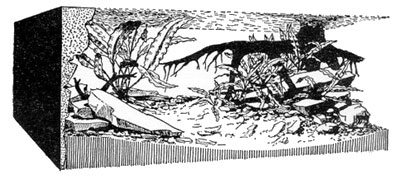 affect the water chemistry. If you really feel the
need to use multicolored gravel, go ahead, but bear in mind that if someone was
to come into your house and paint the walls purple with fluorescent orange
stripes and lime green spots, you probably wouldn’t be too happy about it. I'm
not saying "Don't do it", but I prefer to see fish in a natural environment. If
Nature had intended river beds to be neon blue and candy pink, then they'd be
that color already!
affect the water chemistry. If you really feel the
need to use multicolored gravel, go ahead, but bear in mind that if someone was
to come into your house and paint the walls purple with fluorescent orange
stripes and lime green spots, you probably wouldn’t be too happy about it. I'm
not saying "Don't do it", but I prefer to see fish in a natural environment. If
Nature had intended river beds to be neon blue and candy pink, then they'd be
that color already!
The fish will enjoy digging and rooting around in the substrate for any tasty morsel that may have dropped there. Some species of loach (particularly horseface loaches and dojo/weather loaches) will actively cover themselves until only their eyes poke out.
Plants
Fake or plastic, loaches don’t really mind, but do remember
that they appreciate some vegetable content in their diet. They may also uproot
plants and move them around until they are happy with the way the tank is
planted – which may look radically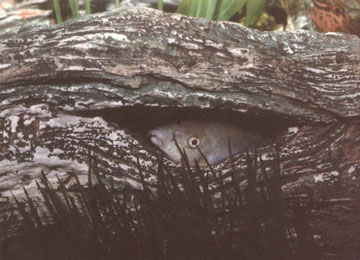 different to the way you intended the tank to
look. They have also been known to punch holes in plants (particularly
echinodorus sp. – amazon swords), sometimes to eat, sometimes for fun.
different to the way you intended the tank to
look. They have also been known to punch holes in plants (particularly
echinodorus sp. – amazon swords), sometimes to eat, sometimes for fun.
Special plant growing equipment such as CO2 injection, fertilizer, substrate additives, etc, are all not really required in order to have a wonderful green tank, full of thriving plants and happy loaches. I personally have great success with hygrophila polysperma and java ferns. The hygrophila because it grows like weeds without any interaction on my behalf, and java ferns because they’re attached to bogwood, and so makes tank maintenance easier as I only need to pick up the wood and move it around the tank without damaging the plant.
Wood and Rockwork
Loaches will almost always require places to go and hide if
startled – therefore provide plenty of nooks and crannies, twisted piles of
bogwood, caves, etc. It may sound unusual, but the higher the number of
boltholes your loaches have, the more likely you are to see them. As always,
make sure that the items you’ve chosen for your aquarium are suitable for use,
and won’t affect the water chemistry. Precautions should be taken to ensure that
any pile of wood or rockwork cannot collapse,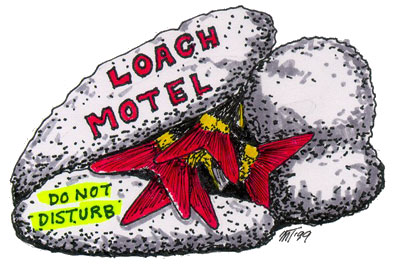 crushing anything that may have
been beneath, or worse still, cracking the glass and causing a tank to burst. Large
rock-work structures should either be avoided, or glued in place with silicone to
prevent rockfalls.
crushing anything that may have
been beneath, or worse still, cracking the glass and causing a tank to burst. Large
rock-work structures should either be avoided, or glued in place with silicone to
prevent rockfalls.
Any hole is irresistible to a loach, and will often jam themselves into it, sometimes in large numbers. Some Botia have been known to take it in turns to peep out from their hidey-hole and watch the rest of the world swim by. A fish that you may think is stuck in a hole probably isn't – it will come out in its own time and only when it’s ready.
Bogwood, Mopani wood, and some driftwoods are all suitable for aquatic use. Make sure that they won’t leach any resins or other substances into the water. Some woods may float initially, but they will soon become water-logged. These can be weighted down by tying them to a heavy stone until the wood becomes saturated, or glued in place with some silicone. Some wood may also require soaking to remove excess tannins from it, as these will affect the water chemistry by softening the water, lowering pH, etc. They will also turn the color of the water a browny "tea" color I find this acceptable in my aquaria, but if it causes concern, then the color can be removed by frequent water changes or filtering with carbon.
Rocks and stones should be chosen carefully, in order to avoid changing the water chemistry or leaching metals into the water (avoid any that show traces of metal ores). Ideal rocks include slate, granite and quartz. Unsuitable rocks would be limestone, marble and sedimentary rock. Lava rock, although extremely lightweight and very easy to shape, is extremely sharp and may cause injury to your fish. There are a number of suitable simulated stone caves on the market now, and these are supposedly inert and so suitable for aquatic use.
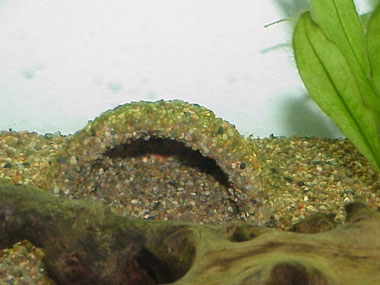 PVC pipes will also make good caves – they lend themselves very
well to making a network of caves by using various joints, etc. Do not use glues
used to cement the pipes together. If you feel compelled to permanently join the
pipes together, use aquatic silicone sealant for this purpose. Normally,
push-fit connectors would be strong enough on their own. The pipes can then be
either left bare, or covered in java moss or ferns, or maybe coated in silicone
sealant and then sprinkled with sand or small gravel while the silicone is still
wet, much in the same way that sparkling glitter would be applied to gift cards.
Normal garden ceramic pots can also be used in this way. It would be best to use
brand new pots as opposed to old and used ones, as the old pots may have been
treated with garden chemicals that may prove toxic to aquatic life.
PVC pipes will also make good caves – they lend themselves very
well to making a network of caves by using various joints, etc. Do not use glues
used to cement the pipes together. If you feel compelled to permanently join the
pipes together, use aquatic silicone sealant for this purpose. Normally,
push-fit connectors would be strong enough on their own. The pipes can then be
either left bare, or covered in java moss or ferns, or maybe coated in silicone
sealant and then sprinkled with sand or small gravel while the silicone is still
wet, much in the same way that sparkling glitter would be applied to gift cards.
Normal garden ceramic pots can also be used in this way. It would be best to use
brand new pots as opposed to old and used ones, as the old pots may have been
treated with garden chemicals that may prove toxic to aquatic life.
Water flow rate
This should be slightly higher than normal, by virtue of the fact that most loaches are from faster moving water than other fish. Look at the shape and design of the fish, and this should become apparent. My Botia dario have all taken on a very streamlined torpedo shape, indicating that the waters in which they came from were fast flowing. Common sense should be applied in that no fish is going to appreciate ridiculously high rates of water turnover. Loaches can often be found playing in the outflow of the filter, taking turns to dance "upstream" in the fast moving water. Some fish have been known to take things too far, and have found themselves ending up in the main body of the filter, with sometimes disastrous consequences. Fish have gone missing on occasions, and the owner, fraught with worry, has torn the tank apart, only to find their missing fish happily playing in the bottom of the filter.
Feeding
Probably the first thing
you’ll notice about your loaches is that they are constantly hungry, and no
amount of food is ever going to stop them wanting more. It is the prime
objective of loach-kind to continually eat ... and eat .... and eat. Fishes in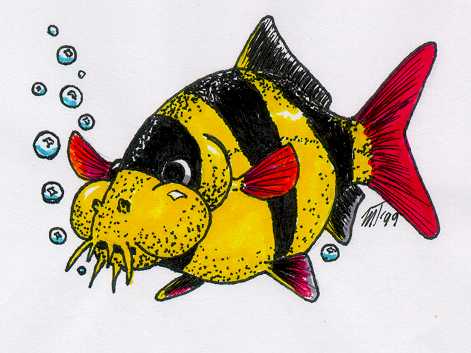 general have no idea when they are full, so what their bodies don’t use, they
excrete back into the water. For this reason, it is best to feed a little and
often, certainly in the case of smaller fish. A small amount of food in the
morning, early evening, and late at night (just before lights out for all the
nocturnal feeders) will be enough to keep your fishes' tummies full, but not
bloated. This is the most efficient way of feeding, as not only does it maximize
the amount of food that is actually used by the fish for growth, etc, but it
also saves money. As an added benefit, it reduces the amount of waste that is
generated, so the filtration works better and won’t need maintaining so often.
general have no idea when they are full, so what their bodies don’t use, they
excrete back into the water. For this reason, it is best to feed a little and
often, certainly in the case of smaller fish. A small amount of food in the
morning, early evening, and late at night (just before lights out for all the
nocturnal feeders) will be enough to keep your fishes' tummies full, but not
bloated. This is the most efficient way of feeding, as not only does it maximize
the amount of food that is actually used by the fish for growth, etc, but it
also saves money. As an added benefit, it reduces the amount of waste that is
generated, so the filtration works better and won’t need maintaining so often.
Feed your fishes sparingly – just enough so that all food is eaten within about 10-15 minutes. Please do not allow food to decay on the substrate in the tank – not only does it add significant amounts of waste product to the filtration system, it also looks a mess. Note that loaches are mostly bottom-dwelling fish, and so are in contact with the substrate an awful lot of the time. Leaving food to decay on the floor of the tank could encourage bacteria to grow, and may infect your fish. Because of the increased load on the filtration, it may even generate Ammonia and Nitrite spikes, both of which are toxic to all fish. In addition, the immune system of the fish may be affected enough to allow the fish to succumb to diseases.
Loaches will feed at all levels of the tank – some may feed from the top, some may feed from the bottom, some may even steal from the mouths of other fishes.
Don’t be too worried if there is fighting between the fish at dinnertime. It is, however, essential to make sure that all fishes are eating something, especially fish that have been recently introduced into the tank.
What to feed?
 A varied diet is essential in keeping your fish in good
condition, as this will ensure that they receive all the necessary vitamins,
carbohydrates, fats and proteins necessary for continued good health and growth.
Also by feeding the same diet, your fish may become "hooked" on that particular
food and refuse to take any other food that is offered to it. Variety is the
spice of life ... after all, you would probably get fed up very quickly if all
you were fed were meat and two veg, day in, day out, week after week ... a
healthy, balanced and nutritious meal, but quite frankly, boring if fed all the
time.
A varied diet is essential in keeping your fish in good
condition, as this will ensure that they receive all the necessary vitamins,
carbohydrates, fats and proteins necessary for continued good health and growth.
Also by feeding the same diet, your fish may become "hooked" on that particular
food and refuse to take any other food that is offered to it. Variety is the
spice of life ... after all, you would probably get fed up very quickly if all
you were fed were meat and two veg, day in, day out, week after week ... a
healthy, balanced and nutritious meal, but quite frankly, boring if fed all the
time.
Don’t expect your loaches to like everything that you offer them. Don’t forget that some people like curry but not pizzas, yet other people may like pizzas but not curry. It is probably a wise idea to purchase a small quantity of any new food just to see if your fishes will take it, before committing to buying in bulk and finding that your loaches view their new "treat" as the piscine equivalent of pork chops and broad beans!
Some people have managed to get their loaches to eat from their fingers (ensure that they’re clean first – your fingers, that is). This is probably because they are so keen to get to the food before anyone else does!
If a fish refuses to come out of its hidey-hole when the dinner-gong sounds, try sucking up some of your loaches favourite food (almost always bloodworm) with a large-bore syringe (a turkey baster is perfect for this job). Then gently release some of the food near to where the fish is hiding.
However, please give the fish time to come out on its own accord – it may come out to look for food after lights-out. Don’t forget that loaches are (supposed to be) nocturnal creatures and will forage for food long after everyone else has gone to bed. If you’re fairly sure a fish hasn’t eaten anything for 3 days or so, then it’s pretty safe to say that something is wrong, and so you should try to find out what the problem is.
Flakes and Wafers
These comprise any quality flake foods, sinking wafers or pellets. Algae wafers are usually guaranteed to get most loaches clicking (and fighting). Certain people have recommended certain brands, but the level of quality is such today, that any well known brand will be suitable and contain all the vitamins and nourishment necessary for your loaches. Certain dried foods may degrade too quickly and foul the water, so always be a little cautious when trying a new brand.
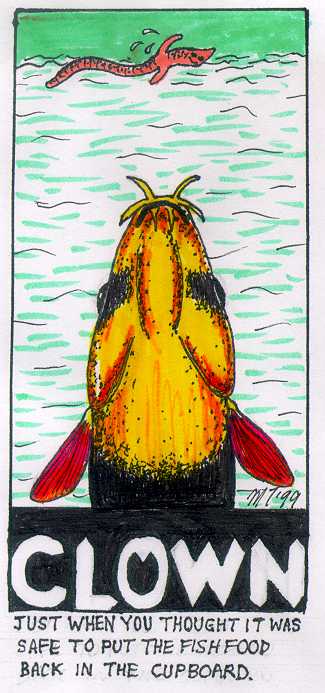 Consider also the size of the loaches mouth, a small or young
fish has a smaller mouth than a large or older one. The size of food should be
suited to the size of mouth. A tiny pinch of micro pellets goes a long way. It
floats and has been known to have loaches writhing at the water surface to grab
their share. You may also want to add conditioner or extra vitamin enriched
foods.
Consider also the size of the loaches mouth, a small or young
fish has a smaller mouth than a large or older one. The size of food should be
suited to the size of mouth. A tiny pinch of micro pellets goes a long way. It
floats and has been known to have loaches writhing at the water surface to grab
their share. You may also want to add conditioner or extra vitamin enriched
foods.
When you buy a brand of flake, open it and smell it. You’ll be surprised. Don’t forget to keep it well closed and in a dry place afterwards. The vitamins in the food deteriorate rapidly. This is why you should always try to buy only as large a tin as you will empty within about six weeks of opening.
Dried Beasties
These comprise freeze dried larvae, brine shrimp, daphnia, tubifex etc. often sold under branded names. Freeze drying preserves the natural nutrients of the animals and at the same time offers a viable alternative to frozen foods. No problems have been reported with these foods to date.
Meaty Foods
Bloodworm seems to be the most popular of meaty foods among loaches – this might be because wiggly wormy things are what loaches eat in the wild. Blackworm, whiteworm, earthworm, daphnia, snails, cyclops, black mosquito larvae, chopped-up shrimp, cockles, and brine shrimp – all will probably be taken with gusto. Your loaches may even accept chopped and cooked chicken or beefheart (remove as much fat as possible) or perhaps even tinned salmon. Tubifex worms have been known to cause a large number of diseases and parasitic infections (as they live in sewage), and so for these reasons are best avoided.
Please note that live foods will need to be washed in running water (particularly bloodworm) as they tend to live in waters that may be contaminated by all sorts of nasties (including sewage). Also, don’t forget that live foods may carry parasites and diseases, not all of which are visible to the naked eye. Some disease treatments and vitamins can be added to live foods (anti-bacterial and anti-parasite treatments for example) prior to feeding. As with all medicines, check the label. Be aware that if the tank is being treated for an ailment, adding live food that has also been treated with a medicine is going to increase the existing dose in the tank. Also check for compatibility if two (or more) medicines will be in contact with each other. Always check the label.
With these points taken into consideration, you might prefer feeding frozen foods (see below) that have been properly treated, washed and prepared. Not only are they safer for your fish, they are also easier to handle. As a bonus, you won’t get moaned at or called a blood-thirsty barbarian by your spouse, partner, children, parents, etc, just for feeding live foods and creating a bit of good old fashioned Roman "entertainment".
If you do want to feed earthworms, please bear in mind the following:
-
Don’t use worms dug from ground that has recently been treated with pesticides, herbicides, fungicides, or ground that has recently been treated with fertilizers (chemical and organic).
-
Worms need to be washed and chopped up to a size suitable for your loaches mouth and it’s going to be YOU that does it!
-
Don’t expect to make yourself popular with your spouse, partner, parents, children, etc by using the food processor/blender or the best knife and chopping board.
Frozen Food
Once again experiment with various brands. Frozen foods offer the convenience of dried food, the variety of live food but without many of the potential problems. Bloodworms are known to be a particular favourite with most loaches but be particularly careful. Some people have noticed that with cheaper brands, there are a lot of dead (bad) worms and they stink.
Brine shrimp are excellent. Allegedly brine shrimp that look green are more nutritious than the orange coloured ones. These are spirulina-loaded shrimp, but they are not always available.
The variety of available frozen foods is amazing: bloodworms, krill, brine shrimp, mysis, and cyclops to name but a few. You can either put them into a container to defrost naturally, or put the frozen portion directly into the aquarium where the heat of the water will quickly defrost it. Whatever you do, don't put them in the microwave. The protein in frozen food has already broken down to a large extent therefore heating the food only causes a mess. Most people prefer to defrost the food in a container, as this allows them to strain away the excess water and to give the food a rinse before adding it to their aquarium. It is not, however, absolutely necessary. Indeed, since frozen blocks can stick to the side of an aquarium (at least for a short while) it is for you, the spectator, more spectacular to add a frozen cube and watch your fishes' feeding frenzy.
Cultures
Many hobbyists like to ‘grow their own’. Cultures of Daphnia, brine shrimp, red wrigglers, grindel worms, vinegar eels, microworms and others are not unknown. Methods for some of which are given below:
 "African Red Wriggler" worms. These are much smaller and softer
than earthworms. Loaches go absolutely bonkers over them – Suck 'em right up!
It's quite something to watch the loaches wrestling with a live food item that
puts up a fight. The worms can be bred in a 'vermi-composter'. Grind up veggie
peelings and browned lettuce leaves and some eggshells. The worms will grow
quickly, but keep the parent worms (some of them can get too big). Wait for the
smaller baby worms to appear. They look and act basically like dew worms or
earthworms but they are smaller and stay smaller. They can't live in the garden
soil in a temperate climate as this will be too cold. They originate from Africa
and are used by some people to make compost out of kitchen scraps. Do not add
leftover meat or scraps, dairy produce, oil or fat to the compost. The worms
like to eat veggies, fruits and grains. So, leftover rice, oatmeal, dry bread,
carrot peelings, brown lettuce whatever. They live in a substrate made of peat
moss, a little soil and ground up non-inked newsprint paper. After a few months
they will have eaten up everything and the box is full of worm castings. Then
the fun begins to separate the worms from the castings. The castings are great
for houseplants or the garden and the worms are great for the fish. Just don’t
feed too many at a time. You will need to find a friend to get the original seed
colony. A supply of worms might also be found in adverts in fish-keeping or
gardening magazines, or quite possibly from a good garden centre.
"African Red Wriggler" worms. These are much smaller and softer
than earthworms. Loaches go absolutely bonkers over them – Suck 'em right up!
It's quite something to watch the loaches wrestling with a live food item that
puts up a fight. The worms can be bred in a 'vermi-composter'. Grind up veggie
peelings and browned lettuce leaves and some eggshells. The worms will grow
quickly, but keep the parent worms (some of them can get too big). Wait for the
smaller baby worms to appear. They look and act basically like dew worms or
earthworms but they are smaller and stay smaller. They can't live in the garden
soil in a temperate climate as this will be too cold. They originate from Africa
and are used by some people to make compost out of kitchen scraps. Do not add
leftover meat or scraps, dairy produce, oil or fat to the compost. The worms
like to eat veggies, fruits and grains. So, leftover rice, oatmeal, dry bread,
carrot peelings, brown lettuce whatever. They live in a substrate made of peat
moss, a little soil and ground up non-inked newsprint paper. After a few months
they will have eaten up everything and the box is full of worm castings. Then
the fun begins to separate the worms from the castings. The castings are great
for houseplants or the garden and the worms are great for the fish. Just don’t
feed too many at a time. You will need to find a friend to get the original seed
colony. A supply of worms might also be found in adverts in fish-keeping or
gardening magazines, or quite possibly from a good garden centre.
During the summer months, mosquito larvae can be collected nearly every day from any source of stagnant water. Usually it is sufficient to put an old bucket filled with water outside. Add a handful of grass cuttings to the water as this will provide the nutrients for the expected larvae. Then wait for mummy mosquito to do the necessary. When disturbed these larvae tend to head to the bottom, therefore it is wise to leave the net in situ between catches, so that they can easily be taken out. Given the size of the larvae, it is best to use a fine cheesecloth or similar as net. Time to exact your revenge for all those sleepless nights and spoilt barbecues!
Daphnia culture can be set up outside in a spare tank or bucket too. To stop unwanted guests that might eat the daphnia, this should be kept covered. Again be sure to add some grass cuttings and/or yeast to provide food for the daphnia. The seed culture can sometimes be purchased from your LFS, given by a friend or caught from a local pond. If catching ‘wild’ daphnia, please be careful to sort the catch extremely carefully. You might be adding natural predators not only of the daphnia but also of young fish fry.
Brine shrimp can be cultured in specially purchased set-ups. These are available from most local fish shops. It is necessary to add pure salt (aquarium salt) to the water, which should be kept aerated. The eggs are also available from LFS or mail order. Most starter cultures include food for the shrimp, but if this is not available fresh yeast or a fine fry food can be used.
Some loaches will also eat snails (particularly clowns and yoyos) – the fish literally sucks the snail body from out of the shell. The loaches will fight over them, and have been observed swimming around with a pondsnail stuck to the snout. If you have a surplus of snails, feed the snails that can be removed easily, leaving the others to refresh the snail colony.
Vegetables
 Some loaches go crazy-mad for vegetables, and will generate all
sorts of interest when these foods are placed in the tank.
Some loaches go crazy-mad for vegetables, and will generate all
sorts of interest when these foods are placed in the tank.
< These ones are eating broccoli
Not only that, but loaches need some vegetable in their diet. Foods that loaches seem to particularly enjoy are cucumber, courgettes (zucchini), marrow, romaine lettuce, squash, brussel sprouts, cabbage, lettuce and peas. Melon and even banana have been tried, with varying degrees of success.
Plants and algae also form an important part of a loach diet. A general rule of thumb, the more expensive the plant, the tastier it is to a fish! (just kidding). It is important to include vegetable matter in a loach diet as these fish are generally herbivores, and so this must be taken into account. If there is no other vegetable matter for them to eat, please do not leave your loaches to graze away on the algae in the tank, and then wonder why they rip your prize Amazon Swords to shreds.
Cucumbers, zucchini (courgettes), marrow, squash.
- Wash and slice off a piece of vegetable about ¼" thick (about 6 mm) – it doesn’t have to be exact, and either microwave it on high for approximately 30 seconds, or blanch it in boiling water for 1 – 1½ minutes. Allow it to cool, then weight it down with a plant weight or similar (loop the weight through the food). Leaving the skin of the vegetable on makes handling a bit easier. It also gives the fish a natural hoop to swim through when they’ve eaten the insides.
Cabbage, brussel sprouts, lettuce.
- Prepare as per cucumber, etc., although getting the food to stay on the bottom of the tank may prove to be a bit more tricky as there is no handy "ring" to slot a plant weight through. A suitable pebble would probably hold the leaf down.
Peas
- Use either washed fresh or frozen peas (not dried, as these require soaking before feeding). Again, either nuke in the microwave for 30 second or blanch in boiling water for 1 – 1½ minutes. Allow them to cool, and then gently remove the skins by pinching between thumb and forefinger – you’ll probably squash a few at first, but it does come with practice. Owner entertainment is catered (!) for here again, by watching your loaches play football (US – Soccer!) with their dinner.
Melon, banana
- Feed these foods sparingly, and remove after about 2 hours – these foods will probably foul the water in a short space of time. Sadly, no funny antics with these foods for you thought.
Home Cooking
A simple paste can made by parboiling green/yellow squash with fresh beefheart in approximately equal quantities. Place in the blender, add gelatine, and freeze. You can wrap this paste in edible seaweed if you like (make sure the seaweed has been washed thoroughly and cleaned of any "nasties". If you do this, score the seaweed package before freezing to make it easier to break into portions. The loaches will eat the seaweed as well as the paste. Or try the following for the more discerning palette: (Note that all measures are approximate and you can add other ingredients as you wish)
-
1 cup (measured before chopping) of finely chopped, cooked and pealed prawns.
-
2 individual blocks of frozen cod, thawed and chopped finely)
-
½ cup of cooked or defrosted spinach (chopped finely)
-
1 can of V8 juice
-
½ banana mashed
-
1 sachet of gelatine (to set mixture)
METHOD:
Combine all ingredients except gelatine, and mix thoroughly. You can put the stuff in a blender to get a more homogenous mess (sorry, mix) if you want. When mixed, dissolve the gelatine in boiling water (enough to give a thick, but flowable mixture when combined into the mix, use your judgement). If the mix is very cold, pop it into a microwave for a short time to warm, then add the gelatine and combine. Spoon portions into plastic, ziplock bags or freezer bags about 10" square. You should aim for an amount that squeezed out flat is approx. 1/8" to 1/4" thick. Lay the filled (and sealed!) bag on a flat surface to cool. When cold, pop the bag flat into a freezer to set solid. When you want to feed the fish, break off a lump and drop in the tank. Loaches go loopy for it. Everything eats it, everything grows, and everything gets good, wholesome food without the risks of feeding live food.
Adding Vitamins or Medicine to food
There is a trick to getting fish to regenerate damaged fins by having them ingest the B12 vitamin. This not only works but also for fish that eat floating pellets or other foods that expand as they absorb waters, it's easy to get it into their system. Drop the pill into a glass filled with a small amount of warm water and let it dissolve first. Add the food and let it draw in the water and then feed it. Anything that can be dissolved in water could be fed this way. The same principle applies for adding any medicines. With live food such as worms, brine shrimp etc., the vitamins or medication should be added to the water they live in or the food they are given to eat.
Fast Days
No kidding! We tend to feed our fish too much. Everyone does it. The fish come to the glass and practically beg for more. Who can resist the temptation, poor little starving hungry loach? But it isn’t necessary. On the contrary, unless young fry are present, it is better to introduce a fast day once a week or even twice. It will do the fish no harm; because in the wild no fish expects to eat daily. A mature aquarium will contain microelements, especially algae, which can be browsed should the fish really be hungry.
Holidays
Many people panic when leaving for holidays and purchase an
item sold as 'holiday food' from the local shop. This is not necessary, nor are
these blocks necessarily a good idea as some pollute the aquarium. If you are
only going away for a week, then let your fish go hungry. It should do no harm.
If your absence is likely to be longer then either invest in a timed automatic
feeder or make up small packages containing the daily amount of food and ask one
of the family or a neighbour to feed it to the fish.
Automatic feeders both battery operated and electrical are now available to suit any budget and can be used for absences of a month or longer.
If you do ask someone else to undertake to feed your fish, do ensure that you provide the food in handy little packages. Folk who have never kept fish cannot judge the correct amount; this could cause a major disaster in your absence for which they cannot be held entirely responsible.
Feeding Summary
Like all captive kept tropical fish, loaches benefit from being fed small quantities of food little and often. If you can only get flake or other prepared dried foods, this will be perfectly satisfactory. However, if you can add more variety by using some of the other foods mentioned above, then your loaches will certainly appreciate it. Your loaches are as individual as you are, so don’t expect them to eat everything you put in the tank for them. You may have to persevere when trying new foods, it may take a while for the fish to catch onto the idea that it is OK to eat. Remember to remove any uneaten food before it starts to pollute the tank.
Document Actions

